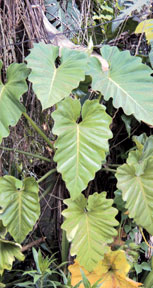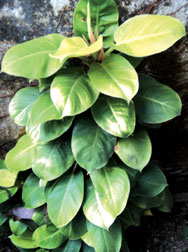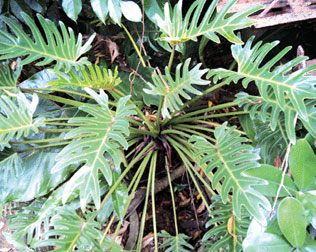|
Philos for Fillers:
Fill out garden spaces with philodendrons
by Palitha SUBASINGHE
Philodendron is a large genus of plants in the Araceae family. The
name derives from the Greek words philo ("love") and dendron ("tree").
According to TROPICOS (a service of the Missouri Botanical Garden) it
consists of close to 900 or more species; other sources quote different
numbers of species. According to them there seem to be between 350 to
700 species.
  Philodendron species can be found in many different habitats in the
tropical Americas and the West Indies Philodendron species can be found in many different habitats in the
tropical Americas and the West Indies
Gardeners find Philodendrons to be among the most popular, tolerant,
and durable of all house plants. Their main feature is their amazing
variety of leaf shapes, sizes and colours. Most of them climb
enthusiastically and often smother their host trees while others grow in
a rosette form with leaves round the central stem. The latter form is
more suitable as potted plants and can be grown as specimen plants.
Many philodendrons are epiphytic in that once they grow on the host
tree with the base in the ground climbing with their ariel roots, they
survive even when the bottom part is destroyed.
The leaves are usually large and imposing, often lobed or deeply cut,
and may be more or less pinnate, (that is, having a central axis and
parts branching from it). They can also be oval, spear-shaped, or many
other possible leaf variations.
The leaves are borne alternately on the stem. An interesting quality
of Philodendrons is that they don't have a single type of leaf on the
same plant. Instead they have juvenile leaves and adult leaves, which
can be somewhat different from one another.
One of the earliest known and grown philodendron is Monstera
deliciosa which has been known as the "cheese plant" in the West.
It has large, beautiful partially divided circular/oval green leaves.
This plant has a unique distinction of being the subject of some of the
experiments conducted by Clive Backster to prove the sensitivity of
plants to human intervention.
Monstera produces a fruit which is said to be palatable but the
writer finds it not to be so at all! Latter introductions include a
variegated form with yellow/cream and white variegations which tend to
burn out if exposed to direct sunlight.
Though most philodendrons are suitable for larger gardens, there are
many recent introductions such as "Painted lady", "miniature selloum"
etc. which can be accommodated in a small garden.
While most philos will grow in shade or dappled light "Painted Lady"
requires more light to give out the lovely colours.
Philodendron "Mahogany" is a robust climber with liver-red young
leaves and given correct light conditions is a gorgeous plant. Later
hybrids have the rosette form and more colourful foliage. Philodendron
"Selloum" is another beautiful plant with its lovely green leaves and
can be grown as a specimen plant.
The writer has seen a variegated form of "selloum" with a grower in
Bangalore and unfortunately he did not have plants to sell (and I did
not have a permit to import!).
"Golden Erubescens " is another philodendron with golden yellow
leaves giving its best colour in the right light conditions.
 Philodendron hastatum variegatum is another lovely plant but
sometimes has the tendency lose the variegations and convert to the
green form. Species verrucosum has broad leaves blotched with purple but
is hard to be seen these days, may be due to the fact that they prefer a
cooler clime. Philodendron hastatum variegatum is another lovely plant but
sometimes has the tendency lose the variegations and convert to the
green form. Species verrucosum has broad leaves blotched with purple but
is hard to be seen these days, may be due to the fact that they prefer a
cooler clime.
The most common of the climbers is Philodendron scandens, or Heart
Shaped Philodendron. This plant gets its name from its leaves, which are
deep green, glossy, and heart shaped.
Another popular climber is P. micans, also known as Velvet
Philodendron. This beauty has the same heart shaped leaves as.
P.scandens, but they have a rich, velvety appearance and the undersides
are tinged with burgundy.
Newer and more exotic varieties "appear" every now and then at the
Vihara Maha Devi Park plant shows and on many occasions specimen plants
carry away the "Best Plant on Show" awards! Unfortunately the importers
do not seem to bother in finding their correct names.
Propagation of philodendron is easy. Stem cuttings with at least two
nodes inserted in a sand/coir dust medium should strike roots quickly.
Also, side shoots appear from the main stem, especially when the
apical portion is damaged and these can be separated and planted in the
same medium till roots are developed. Seeds of a number of philodendrons
such as "Selloum" and "Tuxla"are available in India and elsewhere and
are an option for commercial propagators.
Philodendrons grow in most types of soils. But a medium enriched with
compost, cow dung, leaf mould and river sand will promote robust and
luxuriant growth with proper leaf colour and sheen.
Application of a balanced fertilizer, either as a spray on the leaves
or to the potting mixture will promote healthy growth.
Sometimes the leaves can be damaged by insects and a safe organic
type of insecticidal spray can solve this problem.
The writer is Vice President/Hony. Editor, Horticultural & Flora
Conservation Society, Sri Lanka.
|

